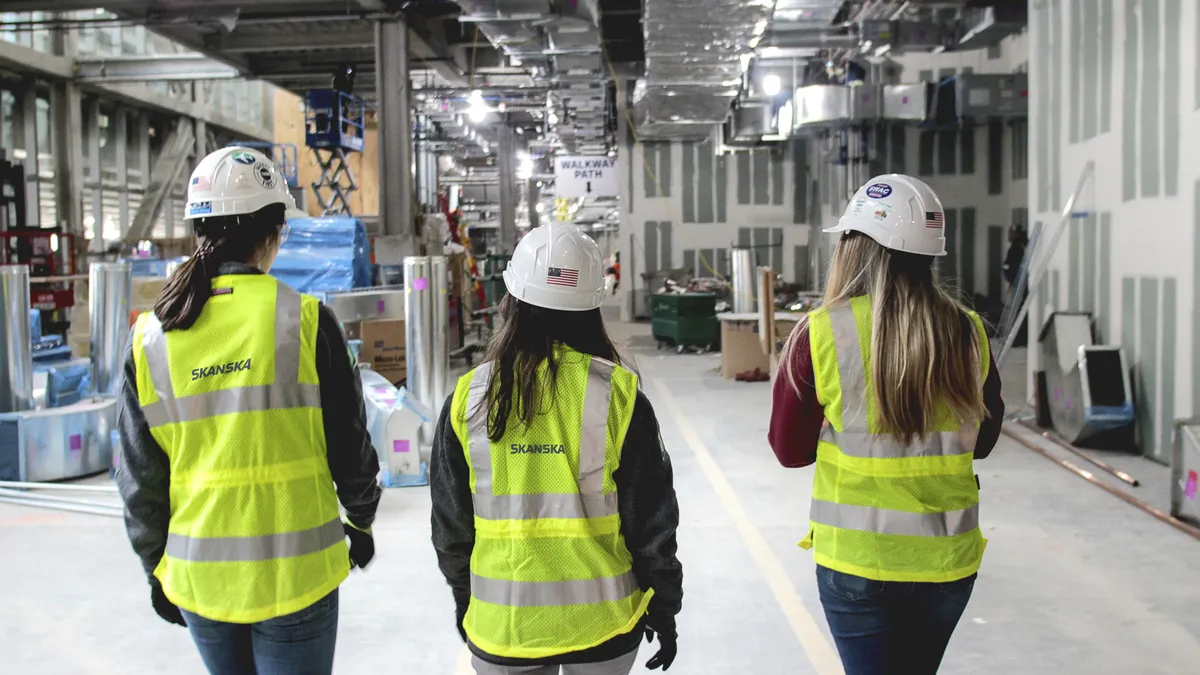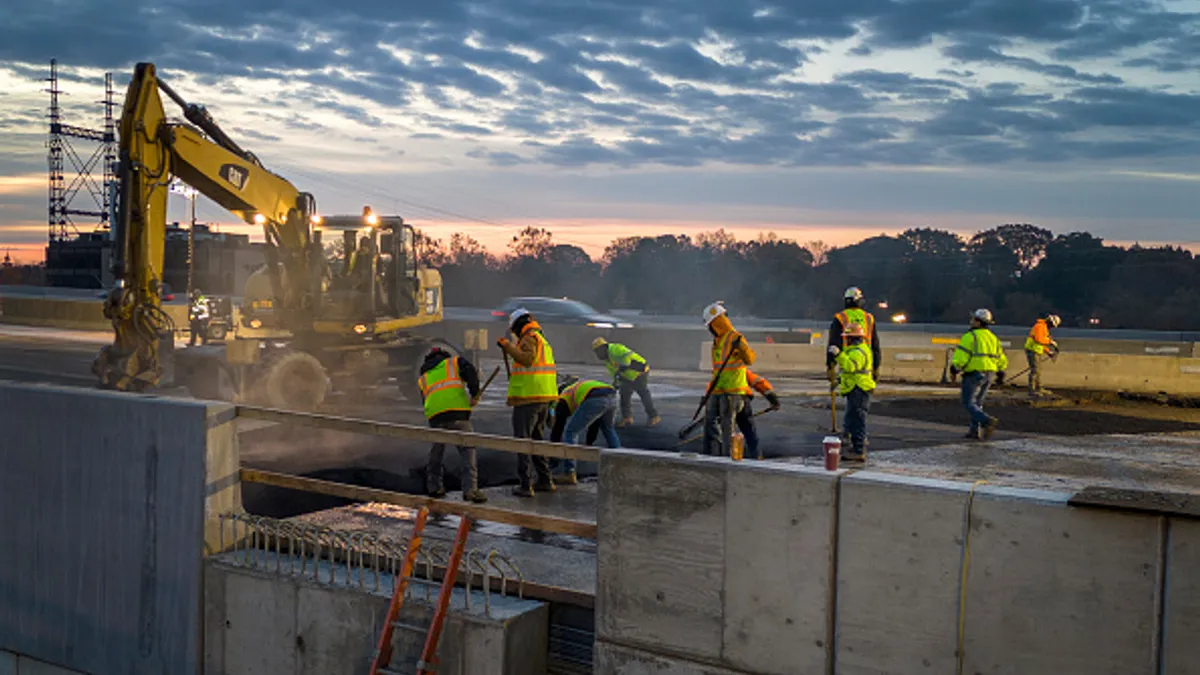The following is a guest post from Larry Dany and Garrett Gibson, a partner and associate based in New York City and Houston, respectively, for law firm Eversheds Sutherland. The opinions expressed are not Construction Dive's, but the authors' own.
Large swathes of the U.S. population are under unprecedented shelter-in-place orders, which exempt only “essential” or “life-sustaining” workers. Some jurisdictions define construction as an essential activity, at least for now. In other jurisdictions construction activity is stopped unless it’s related to healthcare or another specific critical sector. With no choice to discontinue construction, many industry decision-makers are questioning when they might consider declaring force majeure.
However, parties should be practical and not neglect other legal and project management issues that will arise when projects come back online, and take action now to position themselves to facilitate the restart of projects. Because worker and employee safety is the primary consideration of companies now, enforcing measures to keep your personnel safe is the near-term mandate.
So, how can you help put your company in the best position after the world gets back to work? Here are five critical steps:
1. Extensively document the status of the project
Thoughtful demobilization will greatly increase efficient restart of work once restrictions are lifted. Careful documentation of the status of the work before shutdown will provide parties the level of detail necessary to carefully plan for completion of the work well in advance of remobilization, including incorporation of the design changes and/or reprogramming of work necessary to mitigate the impact of the delays.
Documentation should include the status of engineering, design, permits, and inspections. Alignment of the parties on exact status of the work will help with the development of a detailed completion schedule and plan going forward, which will in turn help eliminate disputes by permitting future work to be negotiated and priced well in advance of restart.
Additionally, the reality is that some companies might not survive the shutdown, and in some situations it may make sense to terminate a contract for convenience.
Careful documentation of the status of the work will allow for timely and comprehensive negotiation with a completion or supplementation contractor should such an event arise.
Before a full demobilization, all project participants should perform a comprehensive walkthrough of the site and thereafter create a detailed report of the work in place and completion percentage for each of the scheduled work activities. The status report should be issued for review, comment, and acceptance by the pertinent project participants.
Reliance on project schedule updates may be insufficient, since the actual as-built conditions at the time that work stops may not be captured in the most recent schedule update reporting the status of work that had been being performed during a period of a month or more in the past.
The parties should consider using cameras to photograph and video the work. Photographic and video documentation of work in place will not only help visualize current progress for future planning, but may also reduce any future dispute over the status of any particular element of the work, especially if there is a discrepancy with records such as daily reports or project logs.
Moreover, photographs and videos help capture the quality of the work in place in the event that damage to the work occurs during shutdown. Documentation will confirm that the work was properly secured. This will help facilitate resolution of such issues through insurance once contractors are back on site.
All future work will most likely require a new program and schedule. Uncertainty as to what work is in place and at what level of completion may prevent parties from reaching definitive agreements for restart before the actual remobilization. Good documentation allows for the possibility of negotiating guaranteed prices and binding schedule commitments and associated incentives, which in turn decreases the likelihood of disputes.
2. Record current ‘as built’ safety conditions
Likewise, in addition to having the site properly secured, participants should separately document the “as built” safety conditions of the site at the time of shutdown, with identification of controls in place for known hazardous conditions, such as fire suppression systems, egress, hazardous material storage and fall hazards. This will facilitate orientation of new crews or contractors returning to the site.
The documentation could also be made available to local authorities having jurisdiction so that first responders are aware of site-specific conditions in the event of an incident such as a fire.
3. Separate and track costs
Contractors should identify, separate and track the costs incurred during demobilization, reprogramming and remobilization efforts, especially for current fixed-price contracts.
Job cost records that do not segregate and track cost by task and period, and do not have proper supporting documentation, will result in unnecessary disputes going forward.
4. Order and expedite critical materials and consider alternates
Once nonessential businesses currently in lockdown are allowed to restart, there is likely to be a massive strain on supply chains. There will be a rush on critical materials and resulting shortages, especially if governments authorize construction projects as part of economic stimulus programs.
Parties should look 30 to 60 days ahead and see whether there are materials presently off the site that might be in short supply once work resumes, and consider expediting any material to the site now. The expediting and storage fees will be minimal compared to the cost of delays if certain critical materials are completely unavailable indefinitely.
Also consider countries of origin for materials — certain countries are more disrupted than others; for example, Italian marble might be nearly impossible to export for months, if not years. Parties should carefully identify remaining material needed to complete and consider alternatives well in advance of remobilization, with an eye to how quickly the material can be expedited compared to currently specified material.
5. Identify downstream equipment impacts
Similarly, look ahead on your project schedule and identify critical equipment that was scheduled for certain windows on the project. Pushing the project schedule by 30, 45, or 60 days is going to have a trickle-down effect on the timeline for scheduled equipment, such as cranes, that may be challenging to reschedule.
Additionally, inspection certificates for mechanical equipment already in place may expire before the work restart, so parties should identify which equipment will need inspection and attempt to schedule such inspections before the restart. Get in front of these issues now by making arrangements to reschedule your equipment.
When the world — and construction projects — return to normalcy, inevitably there will be questions about schedule delays and there will be a scramble for labor, materials and equipment. Your company can stay ahead of the curve by taking action now to document the project status, by expediting critical materials and by rescheduling downstream equipment. By taking these steps now, you may be able to stay ahead of your competition and keep your projects on track.





















